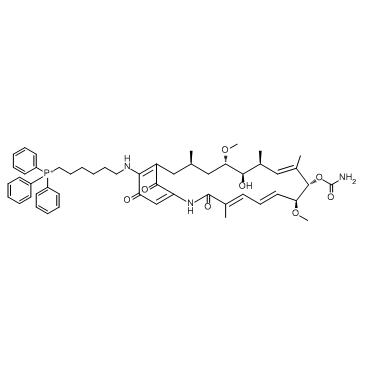| Description |
Gamitrinib TPP is a GA mitochondrial matrix inhibitor. Gamitrinib TPP is offered as the hexafluorophosphate salt (Cat# HY-102007A).
|
| Related Catalog |
|
| Target |
GA mitochondrial matrix[1].
|
| In Vitro |
Within a 16-hour exposure, concentrations of Gamitrinib TPP of 15-20 μM indistinguishably kill patient-derived and cultured glioblastoma cell lines. This cell death response has the hallmarks of mitochondrial apoptosis, with loss of organelle inner membrane potential, release of cytochrome c in the cytosol, activation of initiator caspase-9 and effector caspase-3 and -7, and cellular reactivity for annexin V. Because Hsp90s are selectively present in mitochondria of tumor cells, but not normal tissues, Gamitrinib TPP does not kill normal fetal human astrocytes (FHAS). Under comparable conditions, nonsubcellularly targeted 17-AAG has no effect on normal or tumor cells[1].
|
| In Vivo |
Interestingly, 2 cycles of intracranial TRAIL combined with systemic G-TPP suppress the growth of established glioblastomas, with no significant animal weight loss throughout treatment. Analysis of brain sections from these mice, but not single agent-treated animals, show loss of tumor cell proliferation, internucleosomal DNA fragmentation, and caspase-3 activity, consistent with extensive activation of apoptosis in vivo[1].
|
| Cell Assay |
Human glioblastoma cell lines LN229 (p53 mutant; PTEN, WT), U87 (p53 WT; PTEN mutant), U251 (p53 mutant), prostate adenocarcinoma PC3, breast adenocarcinoma MCF-7, and human epithelial kidney (HEK) 293T are used. The various cell types are seeded in triplicate onto 96-well plates at 2×103 cells/well, treated with vehicle, Gamitrinib TPP (G-TPP), or nontargeted 17-AAG ( 0-20 μM) for up to 24 h, and quantified for metabolic activity by a MTT colorimetric assay with absorbance at 405 nm. For determination of apoptosis, control or treated tumor cell types (1×106) are labeled for annexin V and propidium iodide (PI) and analyzed by multiparametric flow cytometry. For G-TPP-TRAIL combination studies, tumor cell types are simultaneously incubated with suboptimal concentrations of G-TPP at 5 μM and TRAIL depending on the cell type at 100 ng/mL (U87), 20 ng/mL (U251), 40 ng/mL (PC3, MCF-7, FHAS), or 200 ng/mL (LN229), and analyzed after 16 h for cell viability by MTT[1].
|
| Animal Admin |
Mice[1] U87 glioblastoma cells stably transfected with a luciferase expression plasmid (U87-Luc) are suspended in sterile PBS, pH 7.2, and stereotactically implanted (1×105) in the right cerebral striatum of immunocompromised nude mice. Animals with established tumors are randomized in 4 groups (4 animals/group) and started on sterile vehicle (cremophor), TRAIL alone, Gamitrinib TPP alone, or the combination of TRAIL plus Gamitrinib TPP. In all animal groups, TRAIL is injected stereotactically in the right cerebral striatum (2 ng on days 7 and 10 after implantation), and Gamitrinib TPP is given systemically (10 mg/kg as daily i.p. injections on days 6, 7, 9, and 10 after implantation). Treatment is suspended on day 10 after tumor implantation, and tumor growth is assessed weekly by bioluminescence imaging after i.p injection of 110 mg/kg D-luciferin. In some experiments, nude mice carrying established U87-Luc intracranial glioblastomas are treated with systemic Gamitrinib TPP monotherapy at 20 mg/kg as daily i.p. injections and monitored for tumor growth by bioluminescence imaging. Animal survival is calculated per group[1].
|
| References |
[1]. Markus D. Siegelin, et al. Exploiting the mitochondrial unfolded protein response for cancer therapy in mice and human cells. J Clin Invest. 2011 Apr 1; 121(4): 1349–1360.
|
